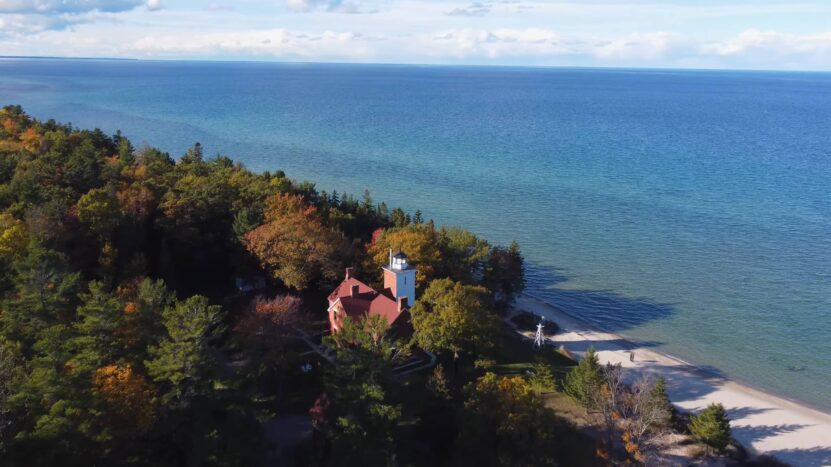Lake Huron, a captivating natural wonder and historical treasure, holds a special place among the Great Lakes. Spanning over 23,000 square miles, it boasts the longest shoreline of its peers and is home to Manitoulin Island, the world’s largest freshwater island.
The lake’s waters conceal a rich history of shipwrecks, making it a prime destination for explorers and history enthusiasts. From the rugged beauty of Georgian Bay to the ecological richness of Saginaw Bay, Lake Huron offers an unparalleled blend of nature and heritage.
Here are 12 key facts and highlights that showcase the unique allure of Lake Huron.
1. Second Largest of the Great Lakes
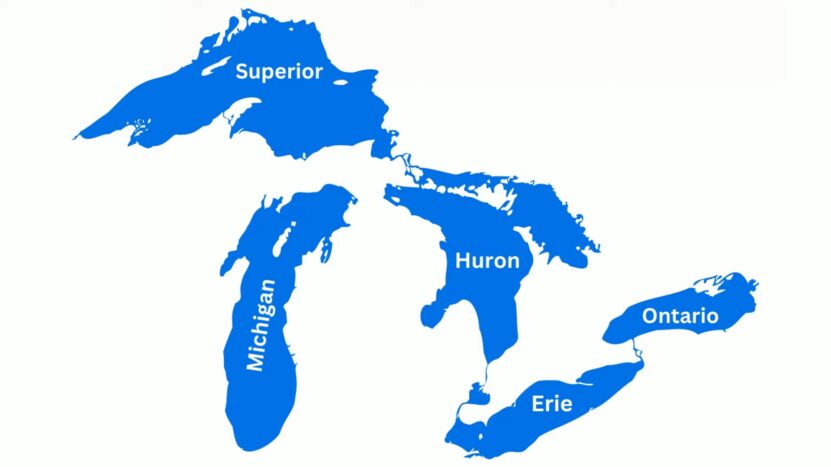
Lake Huron is an impressive body of water, ranking as the second-largest of North America’s Great Lakes by surface area. Covering 23,000 square miles (59,600 square kilometers), it is only slightly smaller than Lake Superior. This immense size provides a vast and varied aquatic landscape that supports a diverse array of marine life and numerous recreational activities.
The lake’s surface area, which is comparable to the size of West Virginia, is only one aspect of its grandeur. Lake Huron’s maximum length stretches over 206 miles (332 kilometers), and its width spans up to 183 miles (295 kilometers) at its widest point. This substantial expanse of water creates numerous opportunities for boating, fishing, and other water-based activities.
Lake Huron’s considerable depth, reaching up to 750 feet (229 meters) in certain areas, contributes to its capacity to hold 850 cubic miles (3,540 cubic kilometers) of water. This vast volume of water not only sustains a rich variety of aquatic species but also plays a crucial role in the hydrology of the Great Lakes system. The lake’s extensive surface and depth provide a dynamic environment that influences weather patterns and supports commercial and recreational navigation.
2. Extensive Shoreline
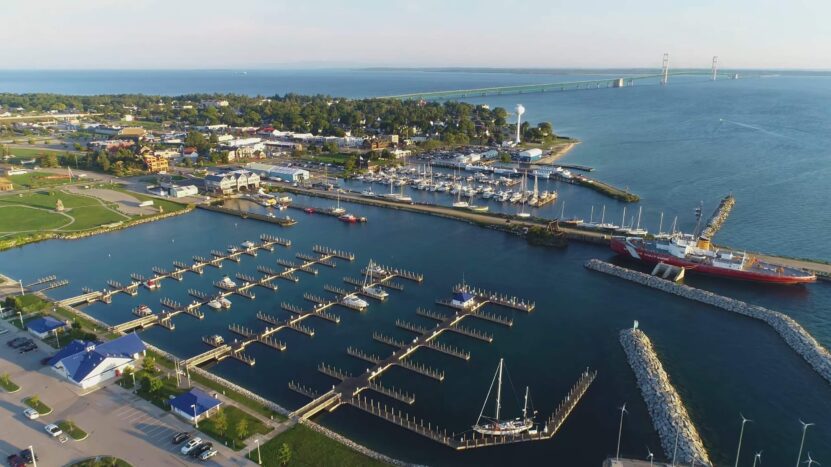
Lake Huron boasts the longest shoreline of all the Great Lakes, with over 3,800 miles (6,100 kilometers) of coastline, including its numerous islands. This extensive shoreline is a mosaic of diverse landscapes, from sandy beaches and rocky cliffs to lush forests and wetlands, offering a multitude of habitats for wildlife and countless opportunities for human enjoyment and exploration.
The sheer length of Lake Huron’s coastline means it touches multiple regions, each with its unique characteristics and attractions. In Ontario, Canada, the shoreline features charming towns, picturesque bays, and the rugged beauty of the Bruce Peninsula. The U.S. side, primarily in Michigan, includes popular vacation spots like Mackinaw City and the scenic shores of the Sunrise Coast.
One of the most notable features of Lake Huron’s shoreline is the “Thirty Thousand Islands” archipelago in Georgian Bay. This collection of islands is the largest freshwater archipelago in the world, renowned for its striking granite outcrops, clear blue waters, and thriving ecosystems. The islands are a haven for boaters, kayakers, and nature enthusiasts who come to experience their unspoiled beauty and rich biodiversity.
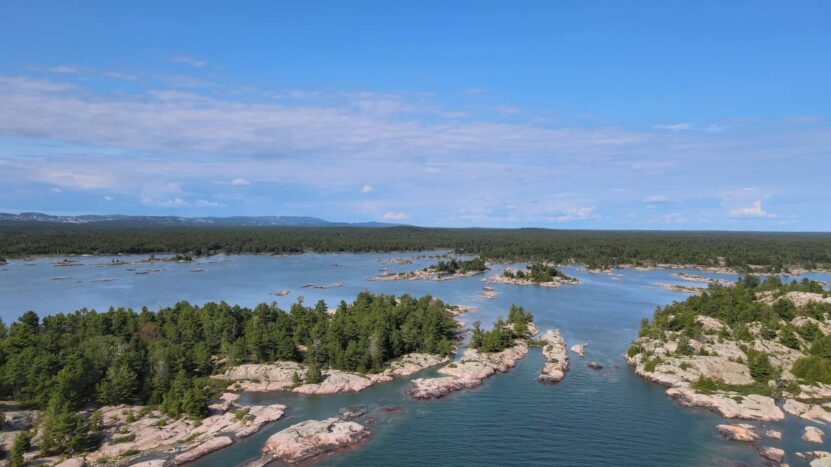
In addition to its natural splendor, the shoreline is dotted with historic lighthouses, quaint fishing villages, and bustling marinas, making it a vibrant and culturally rich region. The diverse environments along Lake Huron’s coastline support a variety of recreational activities, including swimming, fishing, boating, hiking, and bird-watching, ensuring there is something for everyone to enjoy.
3. Manitoulin Island
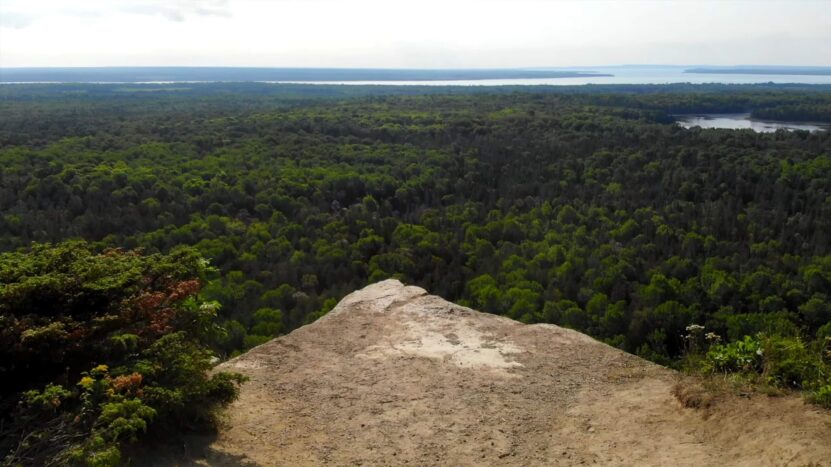
Manitoulin Island, located in Lake Huron, is a remarkable natural wonder, holding the title of the world’s largest freshwater island. Spanning 1,068 square miles (2,766 square kilometers), this island is a unique blend of rich cultural heritage, diverse ecosystems, and breathtaking landscapes, making it a destination of unparalleled interest.
The island’s size is not its only notable feature. Manitoulin Island is dotted with over 100 inland lakes, including Lake Manitou, the largest lake within a freshwater island. These lakes, along with numerous rivers and streams, create a network of aquatic habitats that support a wide variety of fish and wildlife. The island’s diverse terrain, from rugged cliffs and dense forests to fertile farmland, offers a habitat for many species of plants and animals, some of which are rare or endangered.
Culturally, Manitoulin Island is deeply rooted in the traditions of the indigenous Anishinaabe people. The island is home to several First Nations communities, each with a rich cultural heritage that includes traditional crafts, ceremonies, and storytelling. Visitors can explore this cultural richness through various cultural centers, museums, and community events that offer insights into the island’s indigenous history and contemporary life.
The island’s natural beauty and cultural significance make it a popular destination for outdoor enthusiasts and tourists. Hiking trails, such as the Cup and Saucer Trail, offer stunning views of the island and Lake Huron from elevated vantage points. The island’s waters are perfect for boating, fishing, and swimming, while its parks and conservation areas provide excellent opportunities for wildlife viewing and nature walks.
4. Georgian Bay
Georgian Bay, a large bay within Lake Huron, is renowned for its rugged beauty and ecological significance. Spanning an impressive 5,792 square miles (15,000 square kilometers), Georgian Bay is often referred to as the “Sixth Great Lake” due to its vast size and distinctive character. This region is celebrated for its crystal-clear waters, striking granite outcrops, and iconic windswept pines that have inspired artists and nature lovers for generations.
One of Georgian Bay’s most remarkable features is its “Thirty Thousand Islands” archipelago, the world’s largest freshwater archipelago. This labyrinth of islands, islets, and rocky shoals offers a diverse array of habitats for wildlife and a stunning landscape for outdoor enthusiasts. The islands are a haven for boaters, kayakers, and campers who seek solitude and adventure amid the bay’s pristine waters and natural beauty.
The Georgian Bay Islands National Park protects a significant portion of this unique archipelago, preserving its rich biodiversity and natural landscapes. The park is home to a variety of plant and animal species, some of which are rare or endangered. Visitors to the park can enjoy activities such as hiking, bird-watching, and exploring the rugged shoreline.
In addition to its natural wonders, Georgian Bay has a rich cultural history. Indigenous peoples have inhabited the region for thousands of years, and their deep connection to the land is evident in the numerous archaeological sites and cultural landmarks scattered throughout the bay. The area’s European history is also prominent, with historic lighthouses, settlements, and trading posts that tell the story of early explorers and settlers.
Georgian Bay is a popular destination for recreational activities, drawing visitors year-round. In the summer, its warm waters and sandy beaches attract swimmers and sunbathers, while the bay’s excellent fishing spots are favored by anglers. The bay’s islands and mainland offer numerous hiking and biking trails, providing spectacular views and opportunities to experience the area’s natural beauty up close.
5. Shipwrecks and Diving Sites

Lake Huron is home to numerous shipwrecks, making it a treasure trove for divers and maritime historians. Over the centuries, the lake’s treacherous waters have claimed many vessels, leaving behind a rich underwater museum of historic shipwrecks. One of the most notable areas for exploring these submerged relics is the Thunder Bay National Marine Sanctuary, located off the coast of Alpena, Michigan.
The Thunder Bay National Marine Sanctuary spans 4,300 square miles and protects one of America’s best-preserved collections of shipwrecks. The sanctuary is home to nearly 100 known shipwrecks, ranging from wooden schooners and steamers to modern steel-hulled freighters. These wrecks are remarkably well-preserved due to the cold, fresh water of Lake Huron, which slows the decay of wood and metal.
Each shipwreck in Lake Huron tells a story of maritime history, from the early days of Great Lakes shipping to the modern era. Divers can explore vessels like the SS Regina, a steel freighter that sank during the Great Storm of 1913, and the wooden schooner Cornelia B. Windiate, which mysteriously sank with all hands in 1875. These underwater sites provide a fascinating glimpse into the past and offer a unique opportunity for underwater archaeology.
For those interested in exploring Lake Huron’s shipwrecks, the Thunder Bay National Marine Sanctuary offers numerous resources, including detailed maps, dive charters, and educational programs. The sanctuary’s visitor center in Alpena features exhibits on the history of Great Lakes shipping, shipwreck exploration, and the ongoing efforts to preserve these underwater treasures.
In addition to Thunder Bay, other notable shipwreck sites in Lake Huron include the wrecks near Tobermory, Ontario, in the Fathom Five National Marine Park. This area is known as the “Shipwreck Capital of Canada” and offers some of the best freshwater diving in the world. The park protects 22 shipwrecks, including the well-preserved schooner Sweepstakes and the steamer City of Grand Rapids.
6. Environmental Significance
Lake Huron is a vital component of the Great Lakes ecosystem, playing a crucial role in supporting a diverse array of plant and animal species. The lake’s unique ecological features contribute to its importance as a natural habitat and a key element in the environmental health of the region.
One of the most significant aspects of Lake Huron’s environmental importance is its role as a habitat for a variety of fish species. The lake supports a rich fishery, with species such as lake trout, walleye, northern pike, smallmouth bass, and yellow perch thriving in its waters. Lake Huron’s diverse aquatic habitats, including its vast open waters, shallow bays, and underwater reefs, provide ideal conditions for spawning, feeding, and sheltering these fish.
The lake’s shoreline and islands are also home to numerous bird species, making it a crucial area for bird conservation. Wetlands along the coast and on islands provide essential breeding and feeding grounds for waterfowl, shorebirds, and migratory birds. The presence of these diverse bird populations highlights the ecological richness of the Lake Huron region.
In addition to its fish and bird populations, Lake Huron’s coastal wetlands, forests, and dune systems support a variety of plant and animal species, some of which are rare or endangered. These habitats are essential for maintaining biodiversity and ensuring the survival of many species that rely on the lake’s unique environment.
Lake Huron also plays a critical role in regulating the climate and water cycle of the Great Lakes region. The lake’s large surface area and significant water volume influence local weather patterns, helping to moderate temperatures and maintain regional climate stability. Additionally, the lake acts as a reservoir, storing vast amounts of water that contribute to the hydrological balance of the Great Lakes system.
7. Saginaw Bay
Saginaw Bay, a prominent feature on Lake Huron’s western shore, is known for its ecological significance and rich fishing grounds. Covering an area of around 1,143 square miles (2,960 square kilometers), Saginaw Bay is one of the largest and most productive bays in the Great Lakes region.
The bay’s extensive wetlands and shallow waters create an ideal habitat for a variety of fish species, making it a renowned fishing destination. Anglers flock to Saginaw Bay to catch walleye, yellow perch, northern pike, and smallmouth bass, among other species. The bay’s fertile waters support both commercial and recreational fishing, contributing significantly to the local economy.
In addition to its fishing opportunities, Saginaw Bay plays a crucial role in the ecology of Lake Huron. The bay’s wetlands act as natural filters, trapping sediments and pollutants and improving water quality. These wetlands also provide essential breeding and feeding grounds for numerous bird species, including waterfowl, shorebirds, and songbirds. Saginaw Bay is a key stopover point for migratory birds traveling along the Great Lakes flyway.
The bay’s diverse habitats support a wide range of plant and animal species, making it an important area for biodiversity conservation. Efforts to protect and restore the bay’s wetlands and shoreline are ongoing, with organizations and agencies working to address issues such as pollution, invasive species, and habitat loss. These conservation initiatives are critical for maintaining the ecological health of Saginaw Bay and ensuring the sustainability of its natural resources.
Saginaw Bay is also a popular destination for outdoor recreation. Boating, kayaking, and bird-watching are among the many activities that draw visitors to the bay. The Saginaw Bay Water Trail, a designated paddling route, offers an excellent way to explore the bay’s scenic shoreline and diverse ecosystems. The bay’s parks and nature reserves provide ample opportunities for hiking, picnicking, and wildlife viewing, making it a favorite spot for nature enthusiasts.
8. Tourism and Recreation
Lake Huron is a premier destination for tourism and recreation, attracting visitors with its clear waters, scenic landscapes, and abundant outdoor activities. The lake’s extensive shoreline, diverse islands, and unique geological features provide endless opportunities for adventure and relaxation.
One of the most popular activities on Lake Huron is boating. The lake’s vast expanse of water, numerous bays, and sheltered coves make it ideal for all types of boating, from sailing and yachting to kayaking and canoeing. The Georgian Bay area, with its intricate network of islands, is particularly popular among boaters who come to explore its crystal-clear waters and rugged beauty.
Fishing is another major draw for tourists. Lake Huron’s rich fishery offers anglers the chance to catch a variety of species, including walleye, northern pike, smallmouth bass, and lake trout. Saginaw Bay, in particular, is renowned for its excellent walleye fishing, attracting fishing enthusiasts from across the region.
For those who prefer to stay on land, Lake Huron’s shoreline features numerous sandy beaches, perfect for swimming, sunbathing, and beachcombing. Popular beach destinations include Sauble Beach, one of the longest freshwater beaches in the world, and the beaches of Mackinac Island, where visitors can relax and enjoy stunning views of the lake.
Hiking and biking are also popular activities around Lake Huron. The Bruce Peninsula offers some of the best hiking trails, including the famous Bruce Trail, which provides breathtaking views of the lake and the Niagara Escarpment. The island of Manitoulin is another great spot for outdoor enthusiasts, with its network of trails that wind through forests, along lakeshores, and up to scenic lookouts.
Scuba diving and snorkeling are favorite pastimes in areas like Tobermory, located in the Fathom Five National Marine Park. This park is home to numerous shipwrecks and underwater geological formations, offering divers a unique glimpse into the lake’s hidden depths. The clear, cold waters of Lake Huron help preserve these underwater sites, making them fascinating spots for exploration.
In addition to its natural attractions, Lake Huron’s shoreline is dotted with charming towns and villages that offer a range of cultural and recreational experiences. These communities host festivals, markets, and events throughout the year, celebrating everything from local arts and crafts to the region’s maritime heritage.
9. Historical Significance
Lake Huron’s rich history is deeply woven into the fabric of the Great Lakes region. Its shores and waters have witnessed centuries of exploration, trade, conflict, and cultural exchange, making it a treasure trove of historical landmarks and stories.

The indigenous peoples of the Great Lakes, including the Anishinaabe, Huron-Wendat, and Odawa, have lived along the shores of Lake Huron for thousands of years. Their deep connection to the land and water is reflected in numerous archaeological sites, traditional territories, and cultural practices that continue to this day. Artifacts such as tools, pottery, and ancient village sites found along the shoreline offer insights into the early life and sophisticated societies that thrived here long before European contact.
European exploration of Lake Huron began in the early 17th century with French explorers such as Samuel de Champlain and Étienne Brûlé. These explorers mapped the region and established fur trade routes, forming alliances with indigenous nations that were crucial for the fur trade economy. The strategic importance of Lake Huron as a transportation and trade route led to the establishment of several key trading posts and forts along its shores.
One of the most notable historical sites on Lake Huron is Fort Michilimackinac, located at the northern tip of Michigan’s Lower Peninsula. Originally built by the French in 1715, this fort became a vital center for the fur trade and a strategic military outpost during the French and Indian War and the American Revolutionary War. Today, it is a well-preserved historical park where visitors can explore reconstructed buildings, watch reenactments, and learn about the lives of early settlers and soldiers.

Another significant historical landmark is the town of Goderich, Ontario, known as the “Prettiest Town in Canada.” Founded in 1827, Goderich boasts a rich maritime heritage, with its harbor playing a crucial role in the shipping industry. The town’s historic downtown area features beautifully preserved 19th-century architecture and the Huron County Museum, which offers exhibits on the region’s history and development.
The Great Storm of 1913, one of the deadliest maritime disasters in the history of the Great Lakes, left an indelible mark on Lake Huron. This devastating storm claimed 12 ships and took the lives of over 250 sailors. The shipwrecks from this storm, such as the SS Regina and the Charles S. Price, are now haunting underwater monuments that attract divers and serve as reminders of the lake’s perilous waters.
10. Great Lakes Waterway
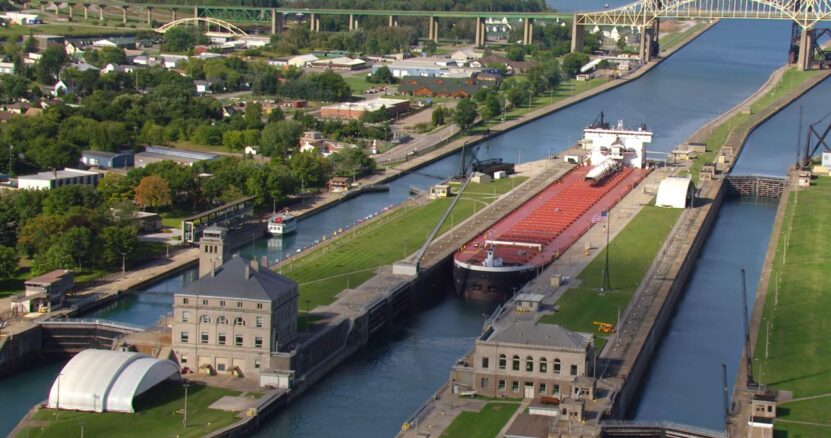
Lake Huron is an integral part of the Great Lakes Waterway, a critical commercial shipping route that connects the Great Lakes to the Atlantic Ocean via the Saint Lawrence Seaway. This extensive waterway system, stretching over 2,340 miles (3,770 kilometers), facilitates the movement of goods and commodities between the interior of North America and international markets, playing a vital role in the region’s economy.
The Great Lakes Waterway includes a series of canals, locks, and channels that allow large vessels to navigate between the Great Lakes and beyond. Lake Huron serves as a crucial link in this system, connecting Lake Michigan to Lake Erie via the Straits of Mackinac and the Detroit River. This connectivity enables the transport of a wide range of cargo, including iron ore, coal, grain, and manufactured goods.
One of the key components of the Great Lakes Waterway within Lake Huron is the St. Clair River, which flows from the southern end of the lake and serves as a natural boundary between the United States and Canada. The river is a busy commercial thoroughfare, with numerous ports and industrial facilities lining its banks. It plays a significant role in facilitating trade and commerce between the two countries.
The Welland Canal, another essential part of the Great Lakes Waterway, bypasses Niagara Falls and connects Lake Erie to Lake Ontario. This canal system allows ships to traverse the 326-foot (99-meter) elevation change between the two lakes through a series of locks. The Welland Canal’s efficient design and operation are vital for maintaining the smooth flow of maritime traffic and enabling the seamless transport of goods.
Lake Huron’s ports and harbors are bustling hubs of activity, supporting a wide range of economic activities. Major ports such as Port Huron in Michigan and Sarnia in Ontario serve as key points for the loading and unloading of cargo. These ports are equipped with modern facilities and infrastructure to handle various types of shipments, contributing significantly to the regional and national economies.
11. Lighthouse Heritage

Lake Huron’s coastline is dotted with historic lighthouses that have guided mariners safely through its waters for centuries. These iconic structures are not only navigational aids but also symbols of the lake’s rich maritime heritage. Each lighthouse has its own unique history and architectural style, adding to the cultural tapestry of the Great Lakes region.
One of the most famous lighthouses on Lake Huron is the Point Clark Lighthouse, located on the Ontario shore. Built in the mid-19th century, this limestone tower stands 87 feet tall and offers stunning views of the lake. It is now a National Historic Site of Canada and hosts tours that provide insight into the life of lighthouse keepers and the challenges they faced in keeping ships safe.
Another notable lighthouse is the Big Tub Lighthouse in Tobermory, Ontario. Situated at the entrance to Big Tub Harbour, this wooden lighthouse has been in operation since 1885. It is located near the Fathom Five National Marine Park, an area known for its clear waters and numerous shipwrecks, making it a popular spot for divers and tourists.
On the U.S. side, the Tawas Point Lighthouse in Michigan is a prominent landmark. This lighthouse, first lit in 1876, sits on the northeastern shore of Michigan’s Lower Peninsula and marks the entrance to Tawas Bay. The lighthouse and its surrounding state park attract visitors for its scenic beauty, bird-watching opportunities, and historical significance.
The Cheboygan River Front Range Lighthouse, also in Michigan, is part of a pair of range lights that helped mariners navigate the tricky waters of the Cheboygan River and Lake Huron. The Front Range Light, built in 1880, is still active today, guiding vessels with its distinctive red and white tower.
The Alpena Lighthouse, or “Alpena Light,” known as “Little Red,” is another key lighthouse on Lake Huron. Located at the entrance to the Thunder Bay River, it has been a crucial aid to navigation since its construction in 1914. The lighthouse is a part of the Thunder Bay National Marine Sanctuary, which protects a significant collection of shipwrecks and maritime history.
12. Unique Geological Features
Lake Huron’s unique geological features add to its allure, providing a diverse landscape that has shaped the region’s natural history and continues to attract geologists, nature enthusiasts, and tourists alike. These features include ancient rock formations, submerged ridges, and distinctive coastal landscapes that offer insights into the lake’s geological past and present.
One of the most fascinating geological aspects of Lake Huron is the Alpena-Amberley Ridge, an ancient submerged ridge that stretches from Alpena, Michigan, to Amberley, Ontario. This ridge was once a land bridge connecting areas now separated by the lake. During the last Ice Age, around 9,000 years ago, this ridge was above water, serving as a migration route for animals and early human inhabitants. Today, it lies about 100 feet below the surface of Lake Huron, and underwater archaeologists have discovered evidence of ancient hunting sites along this ridge, providing valuable insights into prehistoric life in the region.
The Bruce Peninsula, a prominent landform on the Canadian side of Lake Huron, is another notable geological feature. This peninsula is part of the Niagara Escarpment, a long, steep slope that runs from New York through Ontario to Wisconsin. The Bruce Peninsula is characterized by rugged cliffs, deep caves, and lush forests, making it a popular destination for hikers, climbers, and nature lovers. The peninsula’s unique karst topography, formed by the dissolution of soluble rocks such as limestone, creates stunning landscapes and intriguing geological formations.
Flowerpot Island, located within the Fathom Five National Marine Park near Tobermory, Ontario, is famous for its “flowerpot” rock formations. These tall, columnar rocks were shaped by the relentless forces of wind and water erosion over thousands of years, resulting in their distinctive flowerpot-like appearance. The island is a popular spot for visitors who come to marvel at these natural sculptures and explore the surrounding waters and hiking trails.
Last Words
Lake Huron is a true gem of the Great Lakes, known for its immense size, extensive shoreline, and rich history. From the vast waters and unique islands to the historic shipwrecks and diverse wildlife, the lake offers endless opportunities for exploration and enjoyment. Its ecological significance and role in the Great Lakes Waterway highlight its importance to the region.

